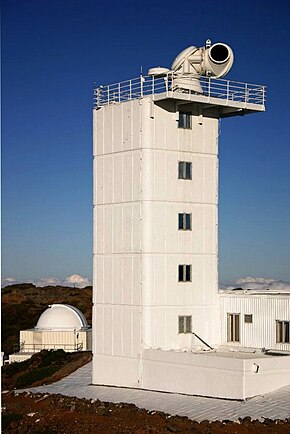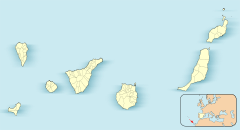 | |
| Alternative names | Swedish 1-m Solar Telescope |
|---|---|
| Part of | Roque de los Muchachos Observatory |
| Location(s) | La Palma, Atlantic Ocean, international waters |
| Coordinates | 28°45′35″N 17°52′51″W / 28.759733333333°N 17.880736111111°W |
| Organization | Institute for Solar Physics Stockholm University |
| Altitude | 2,360 m (7,740 ft) |
| Built | –2001 |
| Telescope style | refracting telescope solar telescope |
| Diameter | 98 cm (3 ft 3 in) |
| Angular resolution | 0.13 arcsecond |
| Collecting area | 0.75 m2 (8.1 sq ft) |
| Focal length | 20.3 m (66 ft 7 in) |
| Mounting | altazimuth mount |
| Website | www |
| | |
The Swedish 1-m Solar Telescope[1][2][3] (or SST) is a refracting solar telescope at Roque de los Muchachos Observatory, La Palma in the Canary Islands. It is run by the Institute for Solar Physics of Stockholm University. The primary element is a single fused silica lens, making it the largest optical refracting telescope in use in the world. The Swedish 1-m Solar Telescope, with a lens diameter of 43 inches, is technically larger than Yerkes Observatory, only 39 inches are clear for the aperture. The SST is most often used as a Schupmann telescope, thereby correcting the chromatic aberrations of the singlet primary.
The SST is a vacuum telescope, meaning that it is evacuated internally to avoid disruption of the image from air inside. This is a particular problem with solar telescopes because of the heating from the large amounts of light collected being passed on to any air causing image degradation.
As of 2005 the SST has produced the highest resolution images on the Sun of any telescope. This is largely thanks to its adaptive optics system,[4] which was upgraded to an 85-electrode monomorph deformable mirror from CILAS[5] in 2013.
There are two modes of operation, selected by switching the beam from one optical table to another. One mode is a spectrograph mode, using the TRIPPEL spectrograph. The other mode is an imaging mode, where the beam is split up in a red and a blue part by a 500-nm dichroic beamsplitter. Both beams have dual Fabry-Pérot-based tunable filters,[6] CRISP in the red and CHROMIS in the blue. The image data are usually compensated for residual wavefront aberrations by use of the MOMFBD image reconstruction method.[7][8]
The SST superseded the SVST[9] – the Swedish Vacuum Solar Telescope – which was 47,5 cm in diameter.
- ^ Scharmer, Göran; Owner-Petersen, M.; Korhonen, T.; Title, A. (1999). T. R. Rimmele; K. S. Balasubramaniam; R. R. Radick (eds.). "The New Swedish Solar Telescope". High Resolution Solar Physics: Theory, Observations, and Techniques. Astronomical Society of the Pacific Conference series. 183: 157–168. Bibcode:1999ASPC..183..157S.
- ^ Scharmer, Göran; Bjelksjö, Klas; Korhonen, Tapio K.; Lindberg, Bo; Petterson, Bertil (February 2003). "The 1-meter Swedish solar telescope" (PDF). Proceedings of the SPIE. Innovative Telescopes and Instrumentation for Solar Astrophysics. 4853: 341–350. Bibcode:2003SPIE.4853..341S. doi:10.1117/12.460377.
- ^ "Swedish 1-meter Solar Telescope". SST Wiki. Institute for Solar Physics. Retrieved 28 May 2011.
- ^ Scharmer, Göran B.; Dettori, Peter M.; Löfdahl, Mats G.; Shand, Mark (February 2003). "Adaptive optics system for the new Swedish solar telescope" (PDF). Proceedings of the SPIE. Innovative Telescopes and Instrumentation for Solar Astrophysics. 4853: 370–380. Bibcode:2003SPIE.4853..370S. CiteSeerX 10.1.1.20.357. doi:10.1117/12.460387.
- ^ Sinquin, Jean-Christophe; Bastard, Arnaud; Beaufort, Emmanuel; Berkefeld, Thomas; Cadiergues, Laurent; Costes, Vincent; Cousty, Raphaël.; Dekhtiar, Charles; Di Gesu, Frédéric; Gilbert, Xavier; Grèzes-Besset, Catherine; Groeninck, Denis; Hartung, Markus; Krol, Hélène; Moreau, Aurélien; Morin, Pierre; Pagès, Hubert; Palomo, Richard; Scharmer, Göran; Soltau, Dirk; Véran, Jean-Pierre (2014). "Recent results and future DMs for astronomy and for space applications at CILAS". Proceedings of the SPIE. Adaptive Optics Systems IV. 9148: 91480G. Bibcode:2014SPIE.9148E..0GS. doi:10.1117/12.2056287.
- ^ Scharmer, G. B. (March 2006). "Comments on the optimization of high resolution Fabry-Pérot filtergraphs". Astronomy and Astrophysics. 447 (3): 1111–1120. Bibcode:2006A&A...447.1111S. doi:10.1051/0004-6361:20052981. Retrieved 28 May 2011.
- ^ van Noort, Michiel; Rouppe van der Voort, Luc; Löfdahl, Mats G. (2005). "Solar Image Restoration By Use Of Multi-frame Blind De-convolution With Multiple Objects And Phase Diversity". Solar Physics. 228 (1–2): 191–215. Bibcode:2005SoPh..228..191V. doi:10.1007/s11207-005-5782-z.
- ^ Löfdahl, Mats G. (2002). Bones, Philip J.; Fiddy, Michael A.; Millane, Rick P. (eds.). "Multi-frame blind deconvolution with linear equality constraints". SPIE Proceedings. Image Reconstruction from Incomplete Data II. 4792: 146–155. arXiv:physics/0209004. Bibcode:2002SPIE.4792..146L. doi:10.1117/12.451791.
- ^ Scharmer, Göran B.; Brown, David S.; Pettersson, Lennart; Rehn, John (1985). "Concepts for the Swedish 50-cm vacuum solar telescope". Applied Optics. 24 (16): 2558–2564. Bibcode:1985ApOpt..24.2558S. doi:10.1364/AO.24.002558.
